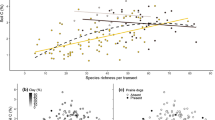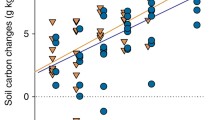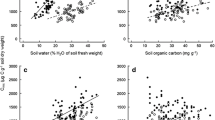Abstract
Grasslands are globally widespread and capable of storing large amounts of carbon (C) in soils, and are generally experiencing increasing atmospheric CO2, nitrogen (N) deposition, and biodiversity losses. To better understand whether grasslands will act as C sources or sinks in the future we measured microbial respiration in long-term laboratory incubations of soils collected from a grassland field experiment after 9 years of factorial treatment of atmospheric CO2, N deposition, and plant species richness on a deep and uniformly sandy soil. We fit microbial soil respiration rates to three-pool models of soil C cycling to separate treatment effects on decomposition and pool sizes of fast, slow, and resistant C pools. Elevated CO2 decreased the mean residence time (MRT) of slow C pools without affecting their pool size. Decreasing diversity reduced the size and MRT of fast C pools (comparing monocultures to plots planted with 16 species), but increased the slow pool MRT. N additions increased the size of the resistant pool. These effects of CO2, N, and species-richness treatments were largely due to plant biomass differences between the treatments. We found no significant interactions among treatments. These results suggest that C sequestration in sandy grassland soils may not be strongly influenced by elevated CO2 or species losses. However, high N deposition may increase the amount of resistant C in these grasslands, which could contribute to increased C sequestration.




Similar content being viewed by others
References
Adair EC, Reich PB, Hobbie S, Knops J. 2009. Interactive effects of time, CO2, N, and diversity on total belowground carbon allocation and ecosystem carbon storage in a grassland community. Ecosystems 12(6):1037–52.
Alvarez R, Alvarez CR. 2000. Soil organic matter pools and their associations with carbon mineralization kinetics. Soil Sci Soc Am J 64(1):184–9.
Antoninka A, Reich PB, Johnson NC. 2011. Seven years of carbon dioxide enrichment, nitrogen fertilization and plant diversity influence arbuscular mycorrhizal fungi in a grassland ecosystem. New Phytol 192(1):200–14.
Cardinale BJ, Srivastava DS, Emmett Duffy J, Wright JP, Downing AL, Sankaran M, Jouseau C. 2006. Effects of biodiversity on the functioning of trophic groups and ecosystems. Nature 443(7114):989–92.
Craine J, Jackson R. 2010. Plant nitrogen and phosphorus limitation in 98 North American grassland soils. Plant Soil 334(1):73–84.
Craine JM, Wedin DA, Reich PB. 2001. The response of soil CO2 flux to changes in atmospheric CO2, nitrogen supply and plant diversity. Glob Change Biol 7(8):947–53.
De Deyn GB, Quirk H, Yi Z, Oakley S, Ostle NJ, Bardgett RD. 2009. Vegetation composition promotes carbon and nitrogen storage in model grassland communities of contrasting soil fertility. J Ecol 97(5):864–75.
De Graaff MA, van Groenigen KJ, Six J, Hungate B, van Kessel C. 2006. Interactions between plant growth and soil nutrient cycling under elevated CO2: a meta-analysis. Glob Change Biol 12(11):2077–91.
DeForest JL, Zak DR, Pregitzer KS, Burton AJ. 2004. Atmospheric nitrate deposition, microbial community composition, and enzyme activity in northern hardwood forests. Soil Sci Soc Am J 68(1):132–8.
Dijkstra FA, Hobbie SE, Knops JMH, Reich PB. 2004. Nitrogen deposition and plant species interact to influence soil carbon stabilization. Ecol Lett 7(12):1192–8.
Dijkstra FA, Hobbie SE, Reich PB, Knops JMH. 2005. Divergent effects of elevated CO2, N fertilization, and plant diversity on soil C and N dynamics in a grassland field experiment. Plant Soil 272(1–2):41–52.
Dijkstra FA, Hobbie SE, Reich PB. 2006. Soil processes affected by sixteen grassland species grown under different environmental conditions. Soil Sci Soc Am J 70(3):770–7.
Ellert BH, Bettany JR. 1988. Comparison of kinetic-models for describing net sulfur and nitrogen mineralization. Soil Sci Soc Am J 52(6):1692–702.
Fissore C, Espeleta J, Nater EA, Hobbie SE, Reich PB. 2010. Limited potential for terrestrial carbon sequestration to offset fossil-fuel emissions in the upper midwestern US. Front Ecol Environ 8(8):409–13.
Fontaine S, Mariotti A, Abbadie L. 2003. The priming effect of organic matter: a question of microbial competition? Soil Biol Biochem 35(6):837–43.
Fontaine S, Bardoux G, Abbadie L, Mariotti A. 2004. Carbon input to soil may decrease soil carbon content. Ecol Lett 7(4):314–20.
Fontaine S, Barot S, Barre P, Bdioui N, Mary B, Rumpel C. 2007. Stability of organic carbon in deep soil layers controlled by fresh carbon supply. Nature 450(7167):277–80.
Fontaine S, Henault C, Aamor A, Bdioui N, Bloor JMG, Maire V, Mary B, Revaillot S, Maron PA. 2011. Fungi mediate long term sequestration of carbon and nitrogen in soil through their priming effect. Soil Biol Biochem 43(1):86–96.
Fornara DA, Tilman D. 2008. Plant functional composition influences rates of soil carbon and nitrogen accumulation. J Ecol 96(2):314–22.
Gill RA, Polley HW, Johnson HB, Anderson LJ, Maherali H, Jackson RB. 2002. Nonlinear grassland responses to past and future atmospheric CO2. Nature 417(6886):279–82.
Gill RA, Anderson LJ, Polley HW, Johnson HB, Jackson RB. 2006. Potential nitrogen constraints on soil carbon sequestration under low and elevated atmospheric CO2. Ecology 87(1):41–52.
Grigal DF, Chamberlain LM, Finney HR, Wroblewski DV, Gross ER. 1974. Soils of the cedar creek natural history area. Agricultural Experiment Station, Miscellaneous Report 123:47–81. University of Minnesota.
Hagedorn F, Spinnler D, Bundt M, Blaser P, Siegwolf R. 2003. The input and fate of new C in two forest soils under elevated CO2. Glob Change Biol 9(6):862–72.
Hansen J, Sato M, Kharecha P, Beerling D, Berner R, Masson-Delmotte V, Pagani M, Raymo M, Royer DL, Zachos JC. 2008. Target atmospheric CO2: where should humanity aim? ArXiv 2:217–31.
He Z, Xu M, Deng Y, Kang S, Kellogg L, Wu L, Van Nostrand JD, Hobbie SE, Reich PB, Zhou J. 2010. Metagenomic analysis reveals a marked divergence in the structure of belowground microbial communities at elevated CO2. Ecol Lett 13(5):564–75.
Heath J, Ayres E, Possell M, Bardgett RD, Black HIJ, Grant H, Ineson P, Kerstiens G. 2005. Rising atmospheric CO2 reduces sequestration of root-derived soil carbon. Science 309(5741):1711–13.
Hess TF, Schmidt SK. 1995. Improved procedure for obtaining statistically valid parameter estimates from soil respiration data. Soil Biol Biochem 27(1):1–7.
Hungate BA, Holland EA, Jackson RB, Chapin FSIII, Mooney HA, Field CB. 1997. The fate of carbon in grasslands under carbon dioxide enrichment. Nature 388(6642):576–9.
Jastrow JD, Miller RM, Matamala R, Norby RJ, Boutton TW, Rice CW, Owensby CE. 2005. Elevated atmospheric carbon dioxide increases soil carbon. Glob Change Biol 11(12):2057–64.
Jobbagy E, Jackson R. 2000. The vertical distribution of soil organic carbon and its relation to climate and vegetation. Ecol Appl 10(2):423–36.
Kaye JP, Hart SC. 1997. Competition for nitrogen between plants and soil microorganisms. Trends Ecol Evol 12(4):139–43.
Keeler BL, Hobbie SE, Kellogg LE. 2009. Effects of long-term nitrogen addition on microbial enzyme activity in eight forested and grassland sites: implications for litter and soil organic matter decomposition. Ecosystems 12(1):1–15.
Kuzyakov Y. 2002. Review: factors affecting rhizosphere priming effects. J Plant Nutr Soil Sci 165(4):382–96.
LeBauer DS, Treseder KK. 2008. Nitrogen limitation of net primary productivity in terrestrial ecosystems is globally distributed. Ecology 89(2):371–9.
Lichter J, Barron SH, Bevacqua CE, Finzli AC, Irving KE, Stemmler EA, Schlesinger WH. 2005. Soil carbon sequestration and turnover in a pine forest after six years of atmospheric CO2 enrichment. Ecology 86(7):1835–47.
Martel YA, Paul EA. 1974. Effects of cultivation on organic-matter of grassland soils as determined by fractionation and radiocarbon dating. Can J Soil Sci 54(4):419–26.
Neff JC, Townsend AR, Gleixner G, Lehman SJ, Turnbull J, Bowman WD. 2002. Variable effects of nitrogen additions on the stability and turnover of soil carbon. Nature 419(6910):915–17.
Paul EA, Harris D, Collins HP, Schulthess U, Robertson GP. 1999. Evolution of CO2 and soil carbon dynamics in biologically managed, row-crop agroecosystems. Appl Soil Ecol 11(1):53–65.
Paul E, Morris S, Böhm S. 2001a. The determination of soil C pool sizes and turnover rates: biophysical fractionation and tracers. In: Lal R, Kimble JM, Follett RF et al., Eds. Assessment methods for soil carbon. Boca Raton (FL): CRC Press. p 193.
Paul EA, Collins HP, Leavitt SW. 2001b. Dynamics of resistant soil carbon of midwestern agricultural soils measured by naturally occurring C-14 abundance. Geoderma 104(3–4):239–56.
Paul E, Morris S, Conant R, Plante A. 2006. Does the acid hydrolysis-incubation method measure meaningful soil organic carbon pools? Soil Sci Soc Am J 70:1023–35.
Paustian K, Parton WJ, Persson J. 1992. Modeling soil organic-matter in organic-amended and nitrogen-fertilized long-term plots. Soil Sci Soc Am J 56(2):476–88.
Pendall E, King JY. 2007. Soil organic matter dynamics in grassland soils under elevated CO2: insights from long-term incubations and stable isotopes. Soil Biol Biochem 39(10):2628–39.
Pendall E, Mosier AR, Morgan JA. 2004. Rhizodeposition stimulated by elevated CO2 in a semiarid grassland. New Phytol 162(2):447–58.
Pregitzer KS, Burton AJ, Zak DR, Talhelm AF. 2008. Simulated chronic nitrogen deposition increases carbon storage in northern temperate forests. Glob Change Biol 14(1):142–53.
Reich PB, Tilman D, Craine J, Ellsworth D, Tjoelker M, Knops J, Wedin D, Naeem S, Bahauddin D, Goth J et al. 2001a. Do species and functional groups differ in acquisition and use of C, N and water under varying atmospheric CO2 and N availability regimes? A field test with 16 grassland species. New Phytol 150(2):435–48.
Reich PB, Knops J, Tilman D, Craine J, Ellsworth D, Tjoelker M, Lee T, Wedin D, Naeem S, Bahauddin D et al. 2001b. Plant diversity enhances ecosystem responses to elevated CO2 and nitrogen deposition. Nature 410(6830):809–12.
Reich PB, Hungate BA, Luo Y. 2006a. Carbon–nitrogen interactions in terrestrial ecosystems in response to rising atmospheric carbon dioxide. Annu Rev Ecol Evol Syst 37(1):611–36.
Reich PB, Hobbie SE, Lee T, Ellsworth DS, West JB, Tilman D, Knops JMH, Naeem S, Trost J. 2006b. Nitrogen limitation constrains sustainability of ecosystem response to CO2. Nature 440(7086):922–5.
Rice C, Garcia F, Hampton C, Owensby C. 1994. Soil microbial response in tallgrass prairie to elevated CO2. Plant Soil 165(1):67–74.
Schlesinger WH. 1997. Biogeochemistry: an analysis of global change. San Diego (CA): Academic Press. p 588.
Scurlock JMO, Hall DO. 1998. The global carbon sink: a grassland perspective. Glob Change Biol 4(2):229–33.
Sollins P, Glassman C, Paul EA, Swanston C, Lajtha K, Heil JW, Elliott ET. 1999. Soil carbon and nitrogen: pools and fractions. In: Robertson GP, Ed. Standard soil methods for long-term ecological research. New York: Oxford University Press. p 89.
Tilman D, Knops J, Wedin D, Reich PB, Ritchie M, Siemann E. 1997. The influence of functional diversity and composition on ecosystem processes. Science 277(5330):1300–2.
Tilman D, Reich PB, Knops J, Wedin D, Mielke T, Lehman C. 2001. Diversity and productivity in a long-term grassland experiment. Science 294(5543):843–5.
Tilman D, Hill J, Lehman C. 2006. Carbon-negative biofuels from low-input high-diversity grassland biomass. Science 314(5805):1598–600.
Treseder KK. 2004. A meta-analysis of mycorrhizal responses to nitrogen, phosphorus, and atmospheric CO2 in field studies. New Phytol 164(2):347–55.
Treseder KK, Allen MF. 2000. Mycorrhizal fungi have a potential role in soil carbon storage under elevated CO2 and nitrogen deposition. New Phytol 147(1):189–200.
van Groenigen KJ, Six J, Hungate BA, de Graaff MA, van Breemen N, van Kessel C. 2006. Element interactions limit soil carbon storage. Proc Natl Acad Sci USA 103(17):6571–4.
van Kessel C, Horwath WR, Hartwig U, Harris D, Lüscher A. 2000. Net soil carbon input under ambient and elevated CO2 concentrations: isotopic evidence after 4 years. Glob Change Biol 6(4):435–44.
Vitousek PM, Howarth RW. 1991. Nitrogen limitation on land and in the sea: how can it occur? Biogeochemistry 13(2):87–115.
von Lützow M, Kögel-Knabner I, Ludwig B, Matzner E, Flessa H, Ekschmitt K, Guggenberger G, Marschner B, Kalbitz K. 2008. Stabilization mechanisms of organic matter in four temperate soils: development and application of a conceptual model. J Plant Nutr Soil Sci 171(1):111–24.
Wolf J, Johnson NC, Rowland DL, Reich PB. 2003. Elevated CO2 and plant species richness impact arbuscular mycorrhizal fungal spore communities. New Phytol 157(3):579–88.
Zak DR, Holmes WE, White DC, Peacock AD, Tilman D. 2003. Plant diversity, soil microbial communities, and ecosystem function: are there any links? Ecology 84(8):2042–50.
Zak DR, Holmes WE, Burton AJ, Pregitzer KS, Talhelm AF. 2008. Simulated atmospheric NO3 − deposition increases soil organic matter by slowing decomposition. Ecol Appl 18(8):2016–27.
Acknowledgments
We thank the undergraduate BioCON interns for field work, Jared Trost and Kally Worm for experimental maintenance and management, and Chris Clark for assistance in the lab. We thank the US National Science Foundation through the Cedar Creek Long Term Ecological Research program (DEB-0080382), LTER (9411972, 0620652), Biocomplexity (0322057), and LTREB (0716587) programs; the US Department of Energy (DE-FG02-96ER62291 and DE-FC02-06ER64158); and the Minnesota Environment and Natural Resources Trust Fund for support of this project. Joseph Reid was supported by NSF IGERT 0504195.
Author information
Authors and Affiliations
Corresponding author
Additional information
Author Contributions
JPR and ECA performed the soil incubations and analyses, and analyzed data. JPR wrote the manuscript with contributions from all co-authors.
Electronic supplementary material
Below is the link to the electronic supplementary material.
Rights and permissions
About this article
Cite this article
Reid, J.P., Adair, E.C., Hobbie, S.E. et al. Biodiversity, Nitrogen Deposition, and CO2 Affect Grassland Soil Carbon Cycling but not Storage. Ecosystems 15, 580–590 (2012). https://doi.org/10.1007/s10021-012-9532-4
Received:
Accepted:
Published:
Issue Date:
DOI: https://doi.org/10.1007/s10021-012-9532-4




